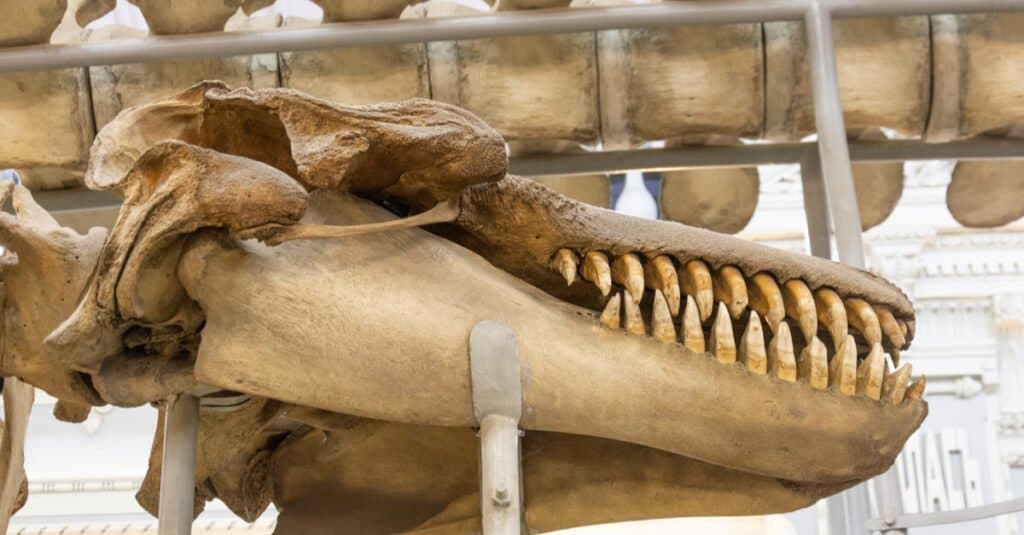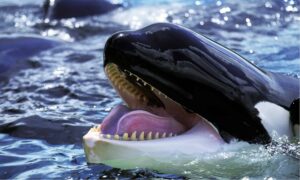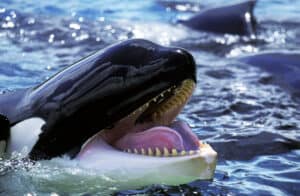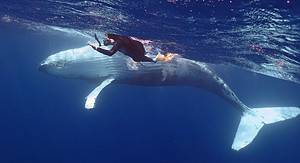When you think about whales, you might automatically think of a blue whale or any cetaceans with no teeth but narrow bristles called baleen. Whales are generally known to eat only plankton and krill, making them harmless to other marine creatures. However, the case is different for killer whales. Unlike most whales that we know of, killer whales eat a carnivorous diet and rely on their incredibly sharp, conical teeth in hunting their prey. Killer whale teeth can measure up to 4 inches long, and despite their cute and cuddly facade, their hunting behaviors are way more aggressive than that of dolphins.
Killer whales belong to the same order as whales, the order Cetacea, but belong to the family of dolphins. More commonly called orcas, killer whales can grow between 23 to 32 feet long and are the biggest members of the Delphinidae family. Orcas have a distinct physical appearance, featuring a black back and white underside. Killer whales may seem like enlarged dolphins, but unlike dolphins who prey on small sea creatures like fish and crustaceans, orcas can go as far as eating larger marine animals like seals, porpoises, and even other whales and sharks.
What Kind of Teeth Do Killer Whales Have?

Killer whales have large, sharp teeth that measure around 3 inches and can grow up to 4 inches.
©aapsky/Shutterstock.com
Killer whales have large, sharp teeth that are conical and interlocking, with their teeth typically measuring around 3 inches in length and approximately an inch in diameter. They can, however, grow longer, reaching 4 inches.
Of around 70 species of whales, more than 50 have teeth instead of baleen. Killer whales are one of them. Killer whale teeth are made up of dentin or ivory, which is somehow kindred to the composition of bones. However, the crown of the killer whale’s teeth is protected by enamel. The growth of dentin in an orca’s teeth can also tell their age.
Toothed whales, like orcas, are monophyodonts, which means they grow only one set of teeth throughout their lifetime. Sharks are usually compared to killer whales because of the similarities in their chosen diet. However, the main difference between the two is their dentition. Sharks are polyphyodont that grow back teeth over and over again. However, once orcas lose a tooth, they can never grow it back.
How Many Teeth Do Killer Whales Have?

Though the numbers vary, killer whales usually have around 40 to 56 teeth.
©Heather Renee/Shutterstock.com
Killer whales have varying numbers of teeth, but they normally possess around 40 to 56 interlocking teeth protruding up to 4 inches long. Killer whales typically have 10 to 14 teeth on each side of their jaw, and all have the same appearance and structure.
Unlike land mammals who have a variety of teeth on their jaws, orcas only have one type of teeth, and all of them look identical to one another –sharp, conical, and cut like a blade. Killer whale teeth are strong and sharp enough to pierce through their victim’s flesh. However, since they do not have molars like most land mammals to chew their food, the killer whale’s teeth are adapted to grab its prey, kill it, and tear it into smaller pieces.
What Do Killer Whales Use Their Teeth For?

As adept hunters, killer whales use their teeth to capture and tear their prey apart.
©Lori Skelton/Shutterstock.com
Killer whales are adept hunters, and despite being a member of the dolphin family, orcas are apex predators. Killer whales use their sharp teeth to capture and tear their prey into smaller, bite-sized fragments. Orcas do not have molars to chew their food, so they don’t grind them. Like sharks, orcas pierce through their victim’s flesh to kill them, and then they either swallow them whole or disintegrate them into smaller pieces before sliding them down their throats. Smaller prey such as fish, salmon, penguins, mackerel, dolphins, squid, seals, and sea lions are swallowed and eaten whole.
Despite being mammals, killer whales are apex predators at sea, hunting open waters and shallow coastal zones. They are known to have quite an insatiable appetite, eating about 500 pounds of food in one day!
You might think that the great white shark, one of the biggest shark species, is usually the ocean’s kings and queens, sitting high up in the marine food chain. This can be true, though, if there are no orcas around. Killer whales kill great whites, easily feeding on these gigantic, predatory fish. Killer whales attack great whites and eat their organs, such as the liver.
Do Killer Whales Have Baby Teeth?
As monophyodonts, killer whales are born with only one set of teeth. This set of teeth will be their teeth for an entire lifetime, and if they lose any of them, they can never grow back. Nevertheless, a complete set of teeth doesn’t seem essential for orcas because killer whales with missing or severely worn teeth are still observed to eat properly.
Baby or young orcas start having their teeth at 11 weeks of age, which is also when they start to eat solid forms of food. Killer whale teeth are susceptible to wear, and older orcas have more extensive wear, especially those whose diet includes sharks with tough skin.
How Strong is a Killer Whale’s Bite?
As killer whales can attack great white sharks without a sweat, it is not surprising that they have a much stronger bite force than them. As one of the planet’s largest predators, orcas have one of Earth’s strongest bite forces. Killer whales can generate a bite force of 19,000 PSI, which is monumental compared to great whites with 4,000 PSI.
Killer whales are also among the fastest marine animals, reaching about 32 to 56 kilometers per hour –pretty impressive for a sea mammal.
Do Killer Whales Attack Humans?
Despite their terrifying names and impressive hunting skills, killer whales are friendly, playful, and curious around humans. They rarely attack them, and there have been no records yet of orcas eating humans. Apart from the fact that humans are not part of their natural diet, orcas behave like dolphins and are incredibly smart.
The photo featured at the top of this post is © Heather Renee/Shutterstock.com
Thank you for reading! Have some feedback for us? Contact the AZ Animals editorial team.







